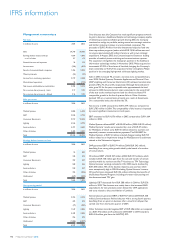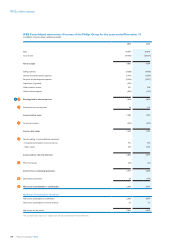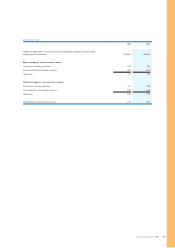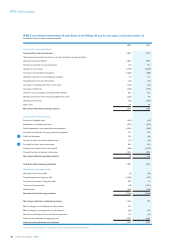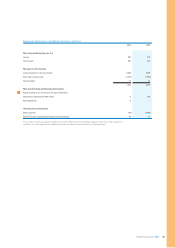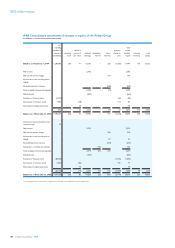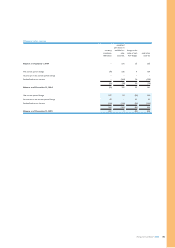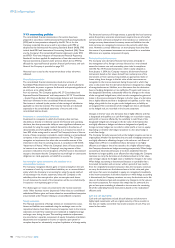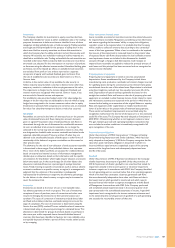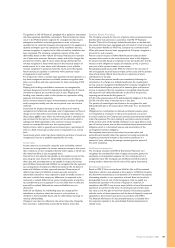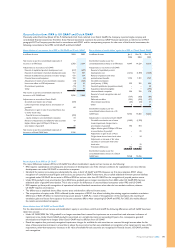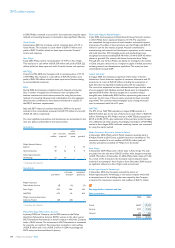Philips 2005 Annual Report Download - page 186
Download and view the complete annual report
Please find page 186 of the 2005 Philips annual report below. You can navigate through the pages in the report by either clicking on the pages listed below, or by using the keyword search tool below to find specific information within the annual report.Philips Annual Report 2005186
IFRS accounting policiesaccounting policies
Theconsolidatednancialstatementsinthissectionhavebeen
prepared in accordance with International Financial Reporting Standards
(IFRS) and its interpretations adopted by the EU. This is for the
Company materially the same as and in accordance with IFRS as
adopted by the International Accounting Standards Board (IASB). IFRS
include both IFRS and International Accounting Standards (IAS). These
aretheCompany’srstconsolidatednancialstatementsunderIFRS
and IFRS 1 ‘First-time Adoption of International Financial Reporting
Standards’ has been applied. An explanation of how the transition from
nancialstatementspreparedunderpreviousDutchlawtoIFRShas
affectedthereportednancialposition,nancialperformanceandcash
owsoftheCompanyisprovidedonpage191.
Historical cost is used as the measurement basis unless otherwise
indicated.
Consolidation principles
Theconsolidatednancialstatementsincludetheaccountsof
Koninklijke Philips Electronics N.V. (the ‘Company’) and all subsidiaries
thatfallunderitspowertogovernthenancialandoperatingpoliciesof
anentitysoastoobtainbenets
from its activities. The Company applies IAS 27 ‘Consolidated and
Separate Financial Statements’ and Interpretation SIC 12 ‘Consolidation
– Special Purpose Entities’. All intercompany balances and transactions
havebeeneliminatedintheconsolidatednancialstatements.
Net income is reduced by the portion of the earnings of subsidiaries
applicable to minority interests. The minority interests are disclosed
separately in the consolidated statements of income and in the
consolidated balance sheets.
Investments in unconsolidated companies
Investments in companies in which the Company does not have
theabilitytodirectlyorindirectlycontrolthenancialandoperating
decisions,butdoespossesstheabilitytoexertsignicantinuence,are
accounted for using the equity method. Generally, in the absence of
demonstrableproofofsignicantinuence,itispresumedtoexistifat
least 20% of the voting stock is owned. The Company’s share of the net
income of these companies is included in results relating to unconsolidated
companies in the consolidated statements of income. The Company
recognizes an impairment loss when the recoverable amount of the
investment is less than its carrying amount, in compliance with IAS 36
‘Impairment of Assets’. When the Company’s share of losses exceeds
its interest in an associate, the Company’s carrying amount of that
associate is reduced to nil and recognition of further losses is discontinued
except to the extent that the Company has incurred legal or constructive
obligations or made payments on behalf of an associate.
Accounting for capital transactions of a subsidiary or an
unconsolidated company
The Company recognizes dilution gains or losses arising from the sale
or issuance of stock by a consolidated subsidiary or an unconsolidated
entity which the Company is accounting for using the equity method
of accounting in the income statement, unless the Company or the
subsidiary either has reacquired or plans to reacquire such shares.
In such instances, the result of the transaction will be recorded directly
in equity as a non-operating gain or loss.
The dilution gains or losses are presented in the income statement
under Other business income (expenses) if they relate to consolidated
subsidiaries. Dilution gains and losses related to unconsolidated companies
are presented under Results relating to unconsolidated companies.
Foreign currencies
Thenancialstatementsofforeignentitiesaretranslatedintoeuros.
Assets and liabilities are translated using the exchange rates on the
respective balance sheet dates. Income and expense items in the income
statementandcashowstatementaretranslatedatweightedaverage
exchange rates during the year. The resulting translation adjustments
are recorded as a separate component of equity. Cumulative translation
adjustments are recognized as income or expense upon partial or
complete disposal or substantially complete liquidation of a foreign entity.
The functional currency of foreign entities is generally the local currency,
unless the primary economic environment requires the use of another
currency. Gains and losses arising from the translation or settlement of
foreign currency-denominated monetary assets and liabilities into the
local currency are recognized in income in the period in which they
arise. However, currency differences on intercompany loans that have
the nature of a permanent investment are accounted for as translation
differences as a separate component of equity.
Derivativenancialinstruments
TheCompanyusesderivativenancialinstrumentsprincipallyin
the management of its foreign currency risks and to a more limited
extent for interest rate and commodity price risks. In compliance
with IAS No. 39, ‘Financial Instruments’, which is early adopted as
fromJanuary1,2004,theCompanymeasuresallderivativenancial
instruments based on fair values derived from market prices of the
instruments or from option pricing models, as appropriate. Gains or
losses arising from changes in the fair value of the instruments are
recognized in the income statement during the period in which they
arise to the extent that the derivatives have been designated as a hedge
of recognized assets or liabilities, or to the extent that the derivatives
have no hedging designation or are ineffective. The gains and losses on
the designated derivatives substantially offset the changes in the values
of the recognized hedged items, which are also recognized as gains and
losses in the income statement. Changes in the fair value of a derivative
thatishighlyeffectiveandthatisdesignatedandqualiesasafairvalue
hedge, along with the loss or gain on the hedged asset, or liability or
unrecognizedrmcommitmentofthehedgeditemthatisattributable
to the hedged risk, are recorded in the income statement.
Changes in the fair value of a derivative that is highly effective and that
isdesignatedandqualiesasacashowhedge,arerecordedinequity,
untilprotorlossareaffectedbythevariabilityincashowsofthe
designated hedged item. Changes in the fair value of derivatives that
are highly effective as hedges and that are designated and qualify as
foreigncurrencyhedgesarerecordedineitherprotorlossorequity,
depending on whether the hedge transaction is a fair value hedge or
acashowhedge.
The Company formally assesses, both at the hedge’s inception and on an
ongoing basis, whether the derivatives that are used in hedging transactions
arehighlyeffectiveinoffsettingchangesinfairvaluesorcashowsof
hedged items. When it is established that a derivative is not highly
effective as a hedge or that it has ceased to be a highly effective hedge,
the Company discontinues hedge accounting prospectively. When hedge
accounting is discontinued because it has been established that the
derivativenolongerqualiesasaneffectivefairvaluehedge,theCompany
continues to carry the derivative on the balance sheet at its fair value,
and no longer adjusts the hedged asset or liability for changes in fair value.
When hedge accounting is discontinued because it is probable that a
forecasted transaction will not occur within a period of two months
from the originally forecasted transaction date, the Company continues
to carry the derivative on the balance sheet at its fair value, and gains
and losses that were accumulated in equity are recognized immediately
in the income statement. In all other situations in which hedge accounting
is discontinued, the Company continues to carry the derivative at its fair
value on the balance sheet, and recognizes any changes in its fair value in
the income statement. For interest rate swaps that are unwound, the
gain or loss upon unwinding is released to income over the remaining
lifeoftheunderlyingnancialinstruments,basedontherecalculated
effective yield.
Cash and cash equivalents
Cash and cash equivalents include all cash balances and short-term
highly liquid investments with an original maturity of three months or
less that are readily convertible into known amounts of cash. They are
stated at face value.
IFRS information


